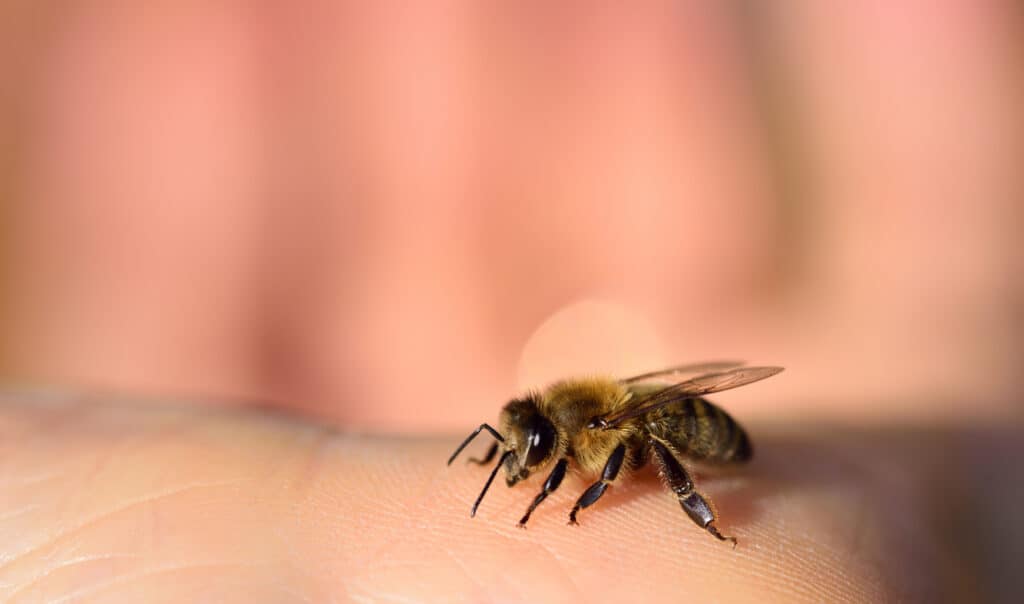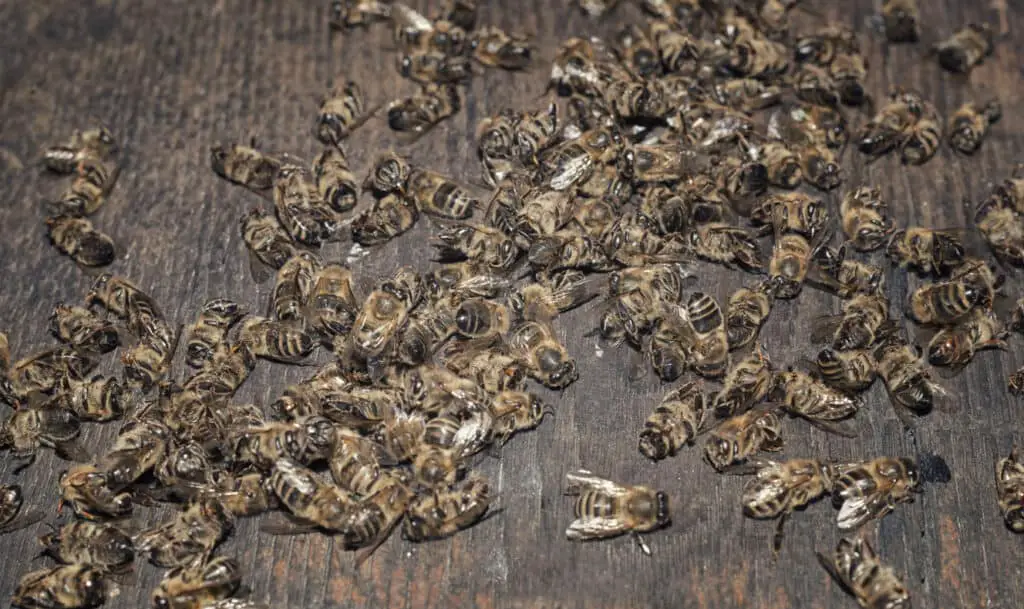Have you ever gone for a lovely spring walk, the flowers blooming, birds singing, and bees buzzing? And during the said walk, did you ever feel a sudden, inexplicable, piercing pain, followed by a burning, throbbing sensation, to which you found a stinger stuck in your hand? Bee stings are usually unpleasant for most of us, but have you ever wondered what happens to the bee? Do bees die after stinging?
A sting is a bee’s penultimate attack when they risk all or nothing to remove a threat from the hive. Some species of bees die after they sting you because their venom gland rips from their body during the stinging process, leaving the stinger embedded in the invader’s skin.
We’re all familiar with bee stings and the bee’s unfortunate death, but why do the bees die? Do all bees die when they sting? Do all bees sting? What benefit does stinging give to bees? And is stinging the only way bees protect themselves?
Why Do Bees Die After Delivering A Sting?

A bee dies after delivering a sting because the stinger does not detach from the sting victim, or the bee’s body, in a way that allows the bee to survive.
Certain bee species have a barbed stinger, which means the stinger is not “smooth,” instead, it has two tiny backward-facing “hooks.” When the stinger becomes embedded in your skin, the hooks prevent the stinger from retracting, so as the bee pulls away, the barbed stinger remains.
These stingers connect to venom glands inside the bees’ abdomen. As the bee pulls away, the barb hooks, tearing the stinger, venom sac, part of the digestive system, muscles, and nerves free from the bee’s body.
This process results in the bee’s death.
A Breakdown Of The Bee Sting Process

The bee’s stinger contains a point sharper than a hypodermic needle. This point punctures the skin with relative ease. As the stinger penetrates, the backward-facing barbs glide into the flesh.
The bee or invader attempts to break the contact, which inadvertently forces the bards on the stinger to dig into the skin, preventing the stinger from exiting. As the bee moves in the opposite direction to the victim, the stinger begins to detach from the bee’s abdomen.
Bees have an open circulatory system, and their blood is called hemolymph. Once the bee tears its stinger and connected organs, the hemolymph (bee blood) drains slowly out of the cavity.
What Happens After A Bee Stings You?
Once a bee with a barbed stinger breaks free, leaving its stinger behind, the muscles on the venom sac continue contracting, further “pumping” the venom into the victim for several minutes.
The bee usually drags itself along for a short distance and slowly dies. The dying process varies, but it can take up to a few hours.
However, the story does not end there. As the bee stings you and rips its stinger out, it releases pheromones into the air. These pheromones are chemical messages that other related honey bees sense.
The message is “intrude, attack!” A behavior they fulfill with gusto. That’s why when you disturb a beehive, you’ll receive multiple stings if you’re not quick enough to retreat.
Can You Save A Bee Once It’s Stung You?
For the most part, a bee whose stinger is barbed and remains inside the victim once stung cannot be saved. Unfortunately, these bees sign their death warrants. The bee is injured irrevocably by pulling its stinger and other important innards from its abdomen.
Do All Bees Receive The Death Sentence For Stinging?

Not all bees die after stinging you. You can judge whether or not that’s good news, but not all bees receive a death sentence when they puncture you with their stingers.
There are roughly 20 000 different bee species distributed across most of the world (excluding the polar regions and some deserts).
Of this multitude of species, only the honeybee (Apis spp.) has barbed stingers which remain in the victim.
Most other species of stinging bees possess a “smooth” (un-barbed) stinger, which means that once the point pierces you and the bee injects its venom into your body, the stinger pulls free easily. After the bee pulls its stinger free, it chooses to move away or sting you again.
Which Bees Die After Stinging?
Honeybees (Apis spp.) are the only known type of bee that die after they sting you.
There are approximately 7 to 10 species of honeybee, most of which have barbed stingers.
These species include:
- Apis mellifera (European/Western Honeybee)
- A. florea (Dwarf Honeybee)
- A. andreniformis (Black Dwarf Honeybee)
- A. dorsata (Giant Honeybee)
- A. cerana (Eastern Honeybee)
- A. koschevnikovi (Koschevnikov’s bee)
- A. nigrocincta (Sulawesian honey bee or the black-banded honey bee)
There are several subspecies of the honeybee, including:
- A. mellifera carnica
- A. mellifera causcasia
- A. mellifera iberiensis
- A. mellifera ligustica
- A. mellifera mellifera
- A. mellifera scutellata
Apis mellifera, the European Honeybee, and various subspecies are the bees that most people come into contact with.
Most other honeybee species are indigenous to parts of Asia, while subspecies are widely distributed globally.
Identifying a honeybee is relatively easy (within reason). Honeybees are social creatures that live in hives, colonies, or nests. What sets honeybees further apart from other bees is that they have a well-developed form of communication.
Upon discovering a new stand of nectar-bearing flowers, honeybees return to the hive and inform the colony about their discovery through dance-like movements. These dances convey specific information, including location, size, quality, and distance to the new food source.
Why Do Some Bees Have Barbed Stingers?
Although it might seem strange that honeybees have a “kamikaze” attack, the reality is that they evolved barbed stingers to use primarily against other insects and only the occasional thick-fleshed creature (mammal), not the other way around.
Barbed stingers result in tremendous physical damage against an invading bee or other insects.
The barb causes damage to the invader’s body as it pulls free. When the barb is embedded in the attacker, it also allows the honeybee to “pump” more venom into the victim by increasing the time the stinger stays in the invader’s body.
Do Bees Know That They Die After They Sting You?
Although there are considerable knowledge gaps in the entomology sciences, it is highly unlikely that bees know that they die once they sting an intruder.
Even if bees “witness” other bees dying from stinging an intruder, that usually does not prevent them from attacking from joining in. On the contrary, when bees sting, they release pheromones which incite their hive mates to sting the intruder.
Bees do not have a well-developed brain, and their reasoning skills are limited.
Even if bees realize and understand that stinging a human causes their death, bees are genetically programmed to defend the colony to death. By sacrificing their own lives, they ensure that the queen and future generations are safe and pass on the genetic information of the hive.
Which Bees Survive After Stinging?
There are roughly 19 500 bee species that can sting you more than once without dying.
Some of the well-known bees in this category include:
- Bumblebees (Bombus spp.)
- Carpenter bees (Xylocopa spp.)
- Solitary bees (over 200 species)
- Honeybee queens (the queen bees get all the luck. These females have smooth stingers and can repeatedly sting without the consequence of getting stuck. However, they usually only sting other queen bees).
Do All Bees Sting?
Of the nearly 20 000 bee species, there are around 500 species that do not sting, either because they don’t have a stinger or because it is too small and ineffective.
Stingless bees belong to the tribe Meliponini, and include:
- Aparatrigona impunctata
- Celetrigona euclydiana
- Cephalotrigona capitata
- Dolichotrigona longitarsis
- Duckeola ghilianii
- Frieseomelitta varia
- Geniotrigona thoracica
- Heterotrigona itama
- Lestrimelitta limao
- Tetragonula carbonaria
- Tetragonula hockingsi
- Tetragonisca angustula
It is critical to note that only female bees sting. A stinger is a modified ovipositor, which means that drones (males) cannot sting as they lack this appendage.
Of equal importance is that most bees are not aggressive and only sting under extenuating circumstances, like when they perceive you as a threat to their hives or if you harass an individual enough that it cannot get away and needs to sting you.
How Do Bees Protect Themselves Without Stinging?
Although bees are almost synonymous with “stinging,” some bee species are unable to sting invaders and require other, creative methods of protecting themselves.
The stingless bees use their powerful mandibles to deliver a painful bite (usually not to humans).
These bees also build extensive and elaborate entrances to discourage invaders and predators.
One bee species, the Japanese honeybees (Apis cerana japonica), use body heat to kill an intruder.
When an invader (particularly the Asian giant hornets (Vespa mandarinia)) threatens a hive, the honeybees swarm over it. They then begin beating their wings and gyrating, increasing the temperature dramatically.
This temperature increase results in the invader’s death.
What Is The Purpose Of A Bee Sting?
Bees are small, weak creatures that produce delicious honey, a natural substance that humans and many other members of the animal kingdom know and love.
It costs time and energy for bees to produce this honey, which they use to feed developing worker bees, queens, and drones.
Bees, therefore, need a way to protect themselves (and their honey) from us predators. Therefore, they evolved a way to defend themselves by stinging intruders with neurotoxic venom. If the venom does not kill an intruder outright, it should be sufficiently painful to deter them from staying in the area.
Consequently, when honeybees (and those with barbed stingers) sting other insects, they don’t often get “stuck.” The issue is when they sting humans and other thick-fleshed creatures (many mammals). The thicker skin and flesh result in the barbs becoming stuck.
How Do Bee Stings Benefit The Colony?
Bees embody the “one for all” motto in its entirety. By sacrificing the life of one or two worker bees, the hive is protected so that future generations may grow to replace them.
Worker bees have a limited life span, so whether they sacrifice themselves for the greater good or not does not influence the overall outcome. The worker bee serves its purpose and dies, replaced by subsequent generations.
How Can You Avoid A Bee Sting?
The best way to prevent the unfortunate death of a honeybee is to not get stung.
Although that seems pretty obvious, there are several actions you can take to avoid being stung.
These actions include:
- Keep flowering parts of your lawn away from frequently accessed areas. We enjoy lush green lawns, but bees start getting underfoot when the plants in-between the grass begin to blossom.
Maintaining a short (manicured) lawn reduces the likelihood of bees buzzing around in areas children, pets, and other family members frequent.
- Take careful note of any bee hives/nests close to your residence or areas you frequent (like parks or walking routes). Once you know where a beehive is, it is much easier to avoid it.
- Avoid the beehive. Unless you’re a beekeeper, researcher, or someone specializing in removing bees, there is usually very little reason to approach a beehive.
- If a honeybee swarm enters an area you’re in, avoid interacting with it. It is better to call a beekeeper/bee removal specialist while you maintain a safe distance.
- During the flowering season, be aware of bee activity. If a honeybee approaches you (and you’re a safe distance away from the hive), remain calm. Honeybees are usually passive and only attack when their hives are disturbed or if they are physically handled/harassed.
Conclusion
While the stigma is that if a bee stings you, it inevitably leads to the bee’s death, it is only accurate concerning honeybees possessing barbed stingers. Many other bee species have smooth stingers, which pull free after stinging without resulting in the bee’s death. Bees use their stingers to protect their hives from invaders, and although a honeybee’s barbed stinger is great against other bees, they meet their demise in human flesh.
References
http://scienceline.ucsb.edu/getkey.php?key=6083
https://www.livescience.com/do-bees-die-after-stinging
https://www.britannica.com/animal/honeybee
https://entnemdept.ufl.edu/creatures/misc/BEES/euro_honey_bee.htm
https://link.springer.com/chapter/10.1007/978-3-319-61839-5_14

